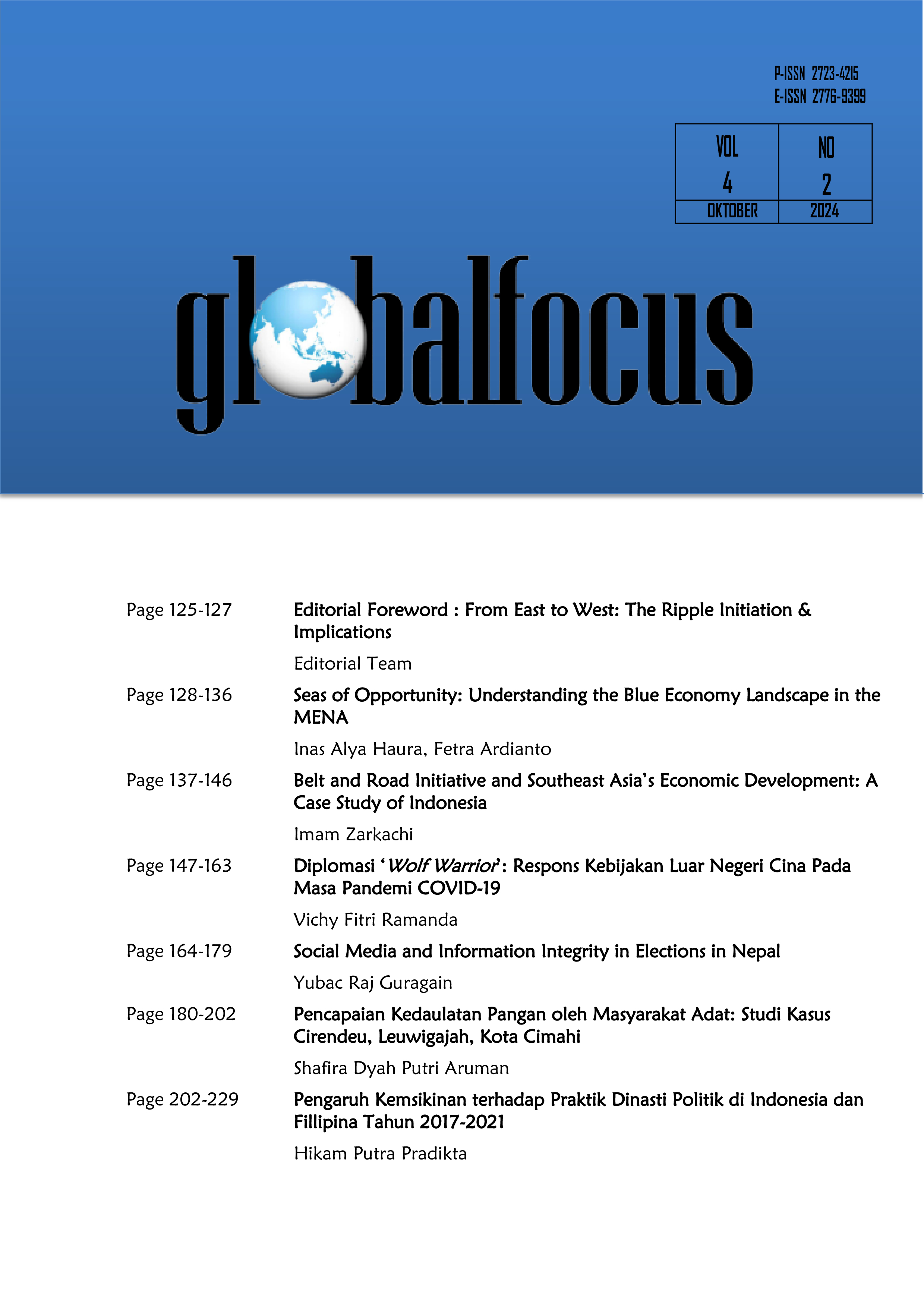Belt and Road Initiative and Southeast Asia's Economic Development: A Case Study of Indonesia
Main Article Content
Abstract
Article Details

This work is licensed under a Creative Commons Attribution-NonCommercial 4.0 International License.

Authors who publish with this journal agree to the following terms:
- Authors retain copyright and grant the journal the right of first publication with the work simultaneously licensed under a Creative Commons Attribution License-NonCommercial 4.0 International that allows others to share the work with an acknowledgment of the work's authorship and initial publication in this journal for non-commercial purposes.
- Authors are able to enter into separate, additional contractual arrangements for the non-exclusive distribution of the journal's published version of the work (e.g., post it to an institutional repository or publish it in a book), with an acknowledgment of its initial publication in this journal.
- Authors are permitted and encouraged to post their work online (e.g., in institutional repositories or on their website) prior to and during the submission process, as it can lead to productive exchanges, as well as earlier and greater citation of published work.
References
Blyth, M. (2002) Great Transformations Economic Ideas and Institutional Change in the Twentieth Century. Cambridge University Press. doi: 10.1017/cbo9781139087230.002.
Cai, P. (2017) ‘Understanding China’s Belt and Road Initiative’, Lowy Institute, (March), p. 26. Available at: https://www.lowyinstitute.org/sites/default/files/documents/Understanding China’s Belt and Road Initiative_WEB_1.pdf.
Clarke, M. (2017) ‘The Belt and Road Initiative: China’s New Grand Strategy?’, Asia Policy, 24(1), pp. 7–15. doi: 10.1353/asp.2017.0023.
Damuri, Y. R. et al. (2014) A Maritime Silk Road and Indonesia’s Perspective of Maritime State, CSIS Working Paper Series. WPPIR-201701.
Fitriani, E. (2018) ‘China’s Belt and Road Initiative (BRI): an indonesian perspective’, China: BRI o el nuevo camino de la seda, pp. 333–348.
Gong, X. (2019) ‘The Belt & Road Initiative and China’s influence in Southeast Asia’, The Pacific Review. Routledge, 32(4), pp. 635–665. doi: 10.1080/09512748.2018.1513950.
Harvey, D. (2007) ‘Neoliberalism as Creative Destruction’, Annals of the American Academy of Political and Social Science, 610, pp. 22–44. doi: 10.1177/0002716206296780.
Huang, Y. (2016) ‘Understanding China’s Belt & Road Initiative: Motivation, framework and assessment’, China Economic Review. Elsevier Inc., 40(2016), pp. 314–321. doi: 10.1016/j.chieco.2016.07.007.
Johnston, L. A. (2018) ‘The Belt and Road Initiative: What is in it for China?’, Asia and the Pacific Policy Studies, pp. 1–19. doi: 10.1002/app5.265.
Keohane, R. O. (1984) After Hegemony: Cooperation and Discord in the World Political Economy, Princeton University Press, Princeton, New Jersey. doi: 10.2307/2617490.
Kindleberger, C. P. (1973) The World in Depression 1929-1939. Berkeley, Los Angeles: Unversity of California Press. doi: 10.3817/0675024173.
Lake, D. A. (2009) ‘Open Economy Politics A Critical Review’, Review of International Organisation, pp. 229–244.
Lovina, H. R., Jiajia, G. and Chen, H. (2017) ‘Review of “The Chinese Belt and Road Initiative”: Indonesia-China Cooperation and Future Opportunities for Indonesia’s Port Cities Development’, Journal of Regional and City Planning, 28(3), pp. 161–177. doi: 10.5614/jrcp.2017.28.3.1.
Martin, L. M. (2013) ‘Neoliberalism in Tim Dunne, Milja Kurki, and Steve Smith’, in Internationa Relations Theories, Discipline and Diversity. Oxford University Press, pp. 110–125. doi: 10.1093/actrade/9780199569250.003.0009.
Nabila, A. et al. (2018) Tenggara Strategics Briefing Paper Belt and Road Initiative (BRI): What’s in it for Indonesia? Jakarta.
Negara, S. D. and Suryadinata, L. (2018) Trends in Southeast Asia: Indonesia and China’s Belt and Road Initiatives: Perspectives, Issues and Prospects. Singapore: ISEAS Publising. doi: 10.1355/9789814818605-002.
Ruggie, J. G. (1982) ‘International Regimes, Transactions, and Change: Embedded Liberalism in the Postwar Economic Order’, International Organization, 36(2), pp. 379–415.
States, F. of the E. U. (2016) China's Belt & Road Initiative China's Belt & Road Initiative : An Introduction. Washington, D.C.
Tekdal, V. (2018) ‘China’s Belt and Road Initiative: at the crossroads of challenges and ambitions’, The Pacific Review. Taylor & Francis, 31(3), pp. 373–390. doi: 10.1080/09512748.2017.1391864.
Vuving, A. L. (2012) ‘The Future of China’s Rise: How China’s Economic Growth Will Shift the Sino-U.S. Balance of Power, 2010-2040’, Asian Politics and Policy, 4(3), pp. 401–423. doi: 10.1111/j.1943-0787.2012.01362.x.
Wang, H. (2019) ‘China's Approach To the Belt and Road Initiative’, Journal of International Economic Law, 22(1), pp. 1–33.
Yu, H. (2017) ‘Motivation behind China’s “One Belt, One Road” initiatives and establishment of the Asian Infrastructure Investment Bank’, Journal of Contemporary China. Routledge, 26(105), pp. 353–368. doi: 10.1080/10670564.2016.1245894.

